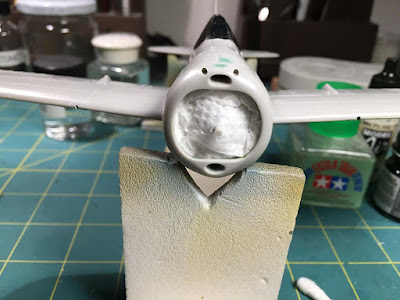The kit really shows its age. What was rather excellent in 1974 is not so excellent today. The biggest issue being the indentations in the moldings. I literally had to fill in the landing gear struts as the plastic shrunk as it cooled leaving indentations. I filled in many of these voids, but finally decided I had to leave well enough alone.
Also typical of older kits, ejection pin markings abound, and they need to be scrapped away and/or filled. Or, in some cases, removal would have caused more damage than I wanted to repair and they were left in place.
The instructions are totally in Japanese. I downloaded a set of instructions from the Tamiya website for one of the current releases of this kit. That gave me the “translation” I was seeking to see what colors they were calling out.
All of the above being said, I really like this model. It is the only 1/48 scale model of the Buffalo available, except for the now out-of-production Classic Airframes kits.
Here are some under-construction photos:
I really miss the Aeromaster line. I know some of the Internet “experts” have referred to them as “Errormaster” based on their sometimes dubious research. That has not been my experience. How often do we have color photos of the actual aircraft we model? And if we do, how accurate are the photo colors after more than seven decades?
Another product used was Montex Mini Mask No. SM 48128 for the canopy and under fuselage window. I hate to trash any product, but these were a real disappointment.
They also had the tendency to pull up the paint on the area next to the masking, even when I attempted to trim the edge of the mask with a #11 blade. The material really clings to the plastic and needs to be pried up with a knife (unlike kabuki tape that comes up with a toothpick). I ended up painting some Tamiya masking tape, cutting it into thin strips and using it to replace the places on the bottom window that pulled away. I should have done that in the first place and saved all the fooling around with the Montex masks and gotten a better looking job!
To be sure, the many very thin frames on this model contributed to the difficulties. None the less, I will not use Montex masks in the future. As Cramer says on his stock market show, “Don’t buy! Don’t buy!” (The few sets of Montex masks I had are now in the landfill.)
The chubby little fighter had to hold the line in the Pacific during the early months of the war. The Marines had them on Wake Island, and the British had them at Singapore and elsewhere, while the Dutch had them deployed in the Pacific with the "Military Air Service of the Royal Netherlands East Indian Army” or ML-KNIL. The Marines regarded the Buffalo as a flying coffin. The British were losing possessions at a breathtaking pace, and they relied on the Buffalos which were no match for more modern and better flown fighters.
Finland was the only country that had success with the Buffalo. Finnish pilots racked up impressive scores flying the Buffalo against the USSR.
The markings I chose were for a Brewster Buffalo Mk I from 488 Sqd, RNZAF, flown by Pilot Officer Noel C. Sharp, at Kallang, Singapore, in late 1941. (For those who are more recent graduates of the American education system, Singapore was a great fortress that the British thought would not fall to the Japanese. Unfortunately, its guns were aimed at the sea, and the Japanese army arrived from the landward side - many riding bicycles to cover terrain faster - where there was little in the way of fortifications. In the end, hubris felled the fortress.)
I weathered the model very little, as the real Buffalos were not in service that long, only a few months. Ultimately this particular aircraft was rendered un-flyable before its capture by the Japanese.Even the less than successful aircraft of WWII were part of history, and I am glad to have the Buffalo in my collection, built up at long last.
These are new photos I took. The first ones I posted were not as good. Also, I painted the pilot figure that came with the model, something I usually do not do. But, I have been painting a few fugures to place with the models on display to show the actual size of the real aircraft.
As always, thank you for visiting my blog, and I look forward to any comments.





























No comments:
Post a Comment